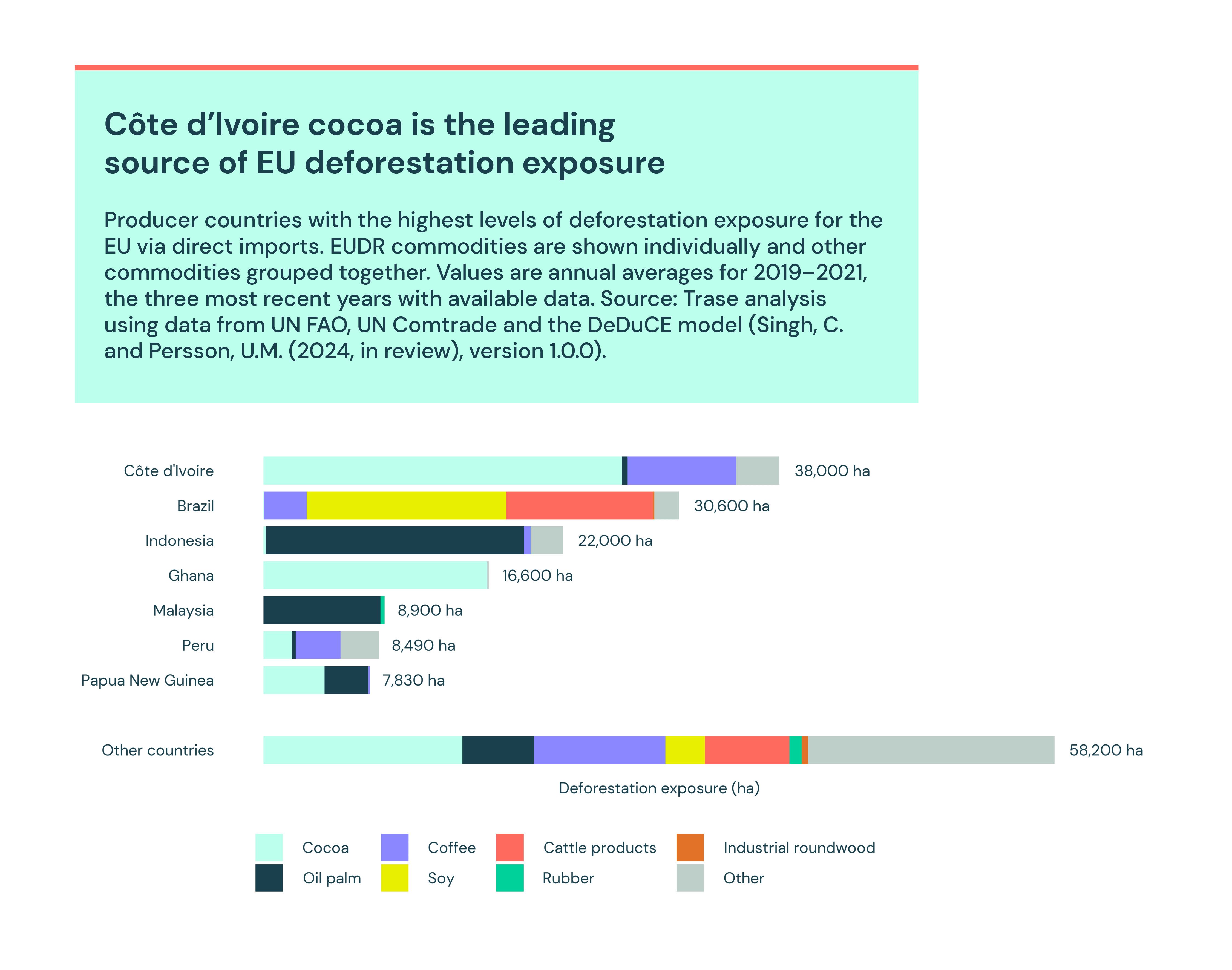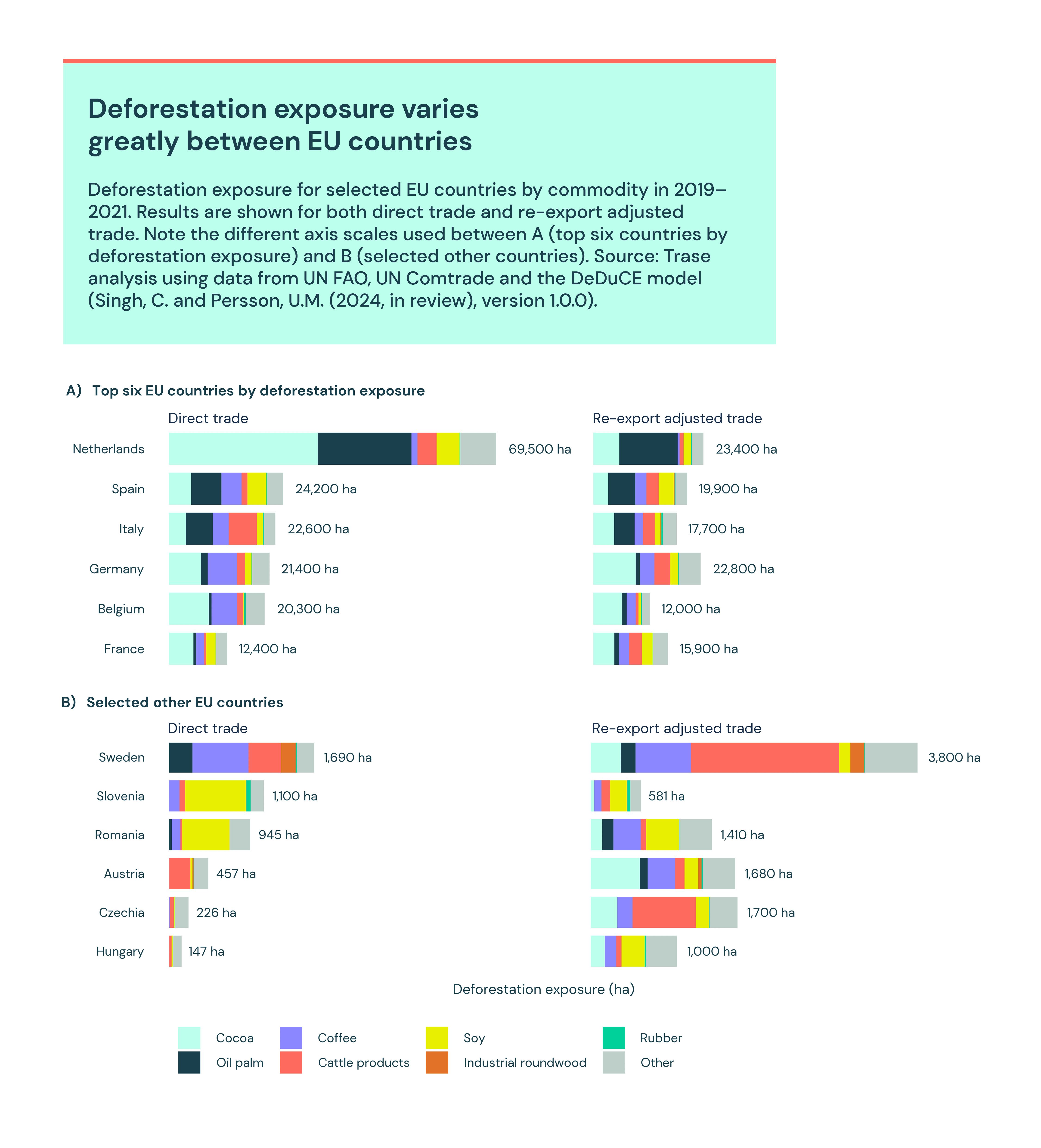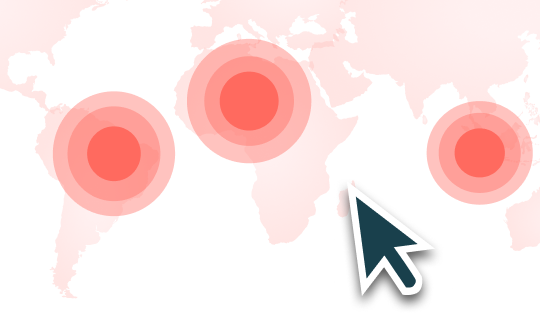From 30 December 2024, EU member states will implement the regulation on deforestation-free products (EUDR), which will require companies to provide evidence that imports of several forest-risk commodities were not produced on recently deforested land. Trase was commissioned by civil society group Fern to assess the deforestation exposure of each EU member state and create a summary factsheet for each that highlights its exposure to deforestation from imports of products included in the EUDR.
Between 2019 and 2021, the EU was exposed to 190,500 hectares (ha) of deforestation on average every year from its direct imports – an area more than ten times the size of Brussels. Over this period, EU imports were associated with 15.0% of the global deforestation linked to direct trade. The top countries of origin for EU exposure were Côte d’Ivoire (19.9%), Brazil (16.0%), Indonesia (11.6%), Ghana (8.7%) and Malaysia (4.7%), which together account for 61% of the EU’s total deforestation exposure.
The top commodities for EU exposure were cocoa (33.7%), oil palm products (19.3%), coffee (13.0%), soy (9.2%), and cattle products (8.9%), which together account for 84% of the EU total. For some commodities, particularly oil palm, rubber and wood, figures are likely to be underestimated since it was not possible to link imports of more processed forms of these commodities to deforestation.

Overall, there has been a substantial decrease in EU deforestation exposure from EUDR commodities in the last few years, amounting to a fall of 35% between 2018 and 2021, despite the quantity of imported commodities remaining high. However, trends vary over time and by commodity, highlighting the need to keep high-risk regions and commodities under constant review.

Most of the overall decrease in exposure is due to a fall in deforestation linked to oil palm production in Indonesia. However, the latest data suggests that deforestation rates are creeping up again, which is not yet reflected in the factsheets. There was also a substantial drop in deforestation exposure from Brazilian soy imports; however, it should be noted that the loss of Brazil’s Cerrado due to the expansion of soy and cattle production is increasing, and this region is largely excluded from the EUDR and the definition of deforestation used for the factsheets.
In contrast, this decline in exposure was not seen for cocoa, coffee or cattle products. Exposure from cocoa remains particularly high, and has generally been trending upwards. The latest Trase data on Côte d’Ivoire, the largest source of the EU’s cocoa deforestation exposure, suggests deforestation rates for cocoa production there remain particularly high. Much of this supply is from indirect sources, making traceability to comply with the EUDR challenging.
Striking differences between EU countries
By comparing the factsheets, differences in exposure between EU countries become clear, especially if we only consider direct trade to the first point of import. For example, the Netherlands’ direct imports were associated with 69,500 ha of deforestation (on average between 2019 and 2021) – nearly triple the next highest, Spain (24,200 ha). The direct imports of landlocked countries like Czechia (226 ha) and Austria (457 ha) had much lower deforestation exposure. This is because the Port of Rotterdam in the Netherlands is an important entry point for imports to the EU. It highlights the crucial role that Dutch authorities will have for enforcing the EUDR requirements on import checks. Considering the re-export of products significantly reduces the Netherlands exposure to 23,300 ha, while Austria’s exposure rises to 1,680 ha, for example.
The commodities responsible for this deforestation exposure also vary greatly from country to country. For example, after adjusting for re-exports, oil palm products were the most important for Netherlands and Spain; whereas for Denmark, Slovenia and Romania, soy was most important. Cocoa was the biggest source of deforestation exposure for Belgium, France, Germany and Italy, while coffee was most important for Portugal. Many EU countries have no direct trade exposure from some commodities such as cocoa, but are more exposed to deforestation indirectly via other EU countries.
These contrasting deforestation footprints suggest that the demands that the EUDR will put upon authorities in different EU member states will vary greatly, highlighting the importance of lesson sharing between countries.

Some commodities outside the EUDR pose substantial risk
The analysis used in the factsheets included a much broader set of agricultural commodities imported into the EU aside from the seven currently covered by the EUDR. This showed that 17.5% of the EU’s deforestation exposure was from commodities not regulated by the EUDR. In the re-export adjusted data, the most important of these was cashew nuts, mostly from West Africa, which had the sixth highest contribution (2.6%) to the EU’s total deforestation exposure. Maize (corn) is also not covered by the regulation, but brings the eighth highest deforestation exposure for the EU (1.9%). Brazil is the most important origin country for maize deforestation exposure.
The factsheets reveal enormous potential for the EUDR to reduce the EU’s exposure to deforestation, and highlight the commodities and countries where this opportunity is greatest for each member state. Furthermore, they show how any delay in implementing the regulation will lead to more deforestation driven by EU consumers. However, due diligence is no silver bullet, and to maximise the regulation’s impact on deforestation rates, it is vital that the EU provides financial and technical support for producers, especially to ensure that smallholder farmers retain access to the EU market. These factsheets can help target this support.
Download Trase factsheets for EU27 countries
Read the methods summary: Titley, M., Croft, S., & West, C. (2024). Factsheets on EU deforestation exposure: Methods summary. Trase. https://doi.org/10.48650/NGRQ-NW62
To reference this article, please use the following citation: Titley, M. (2024). EU27 countries in the spotlight for deforestation exposure. Trase. https://doi.org/10.48650/5XRC-VG04
Was this article useful?





